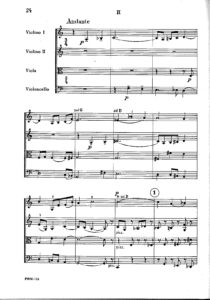The third of Bacewicz’s string quartets was written in 1947, during the composer’s second post-war stay in the French capital, a period during which she enjoyed yet another success as a violinist. When after her return to Poland she was asked by a journalist from Ruch Muzyczny whether she had had time for composing in Paris, Grażyna Bacewicz replied:
I wrote Quartet No. 3 of which I’m proud. There’s something about Paris, something difficult to express in words but conducive to creative work.
String Quartet No. 3 is one of the composer’s most internally balanced works, perhaps the closest in her oeuvre to the ideal of sérénité, characteristic of Gallic spirituality. The work, the outermost elements of which highlight movement as the main creative force, features no extreme situations in terms of expression or use of technical means. Movement is tamed by the logic of motivic links and development of the form, characterised by internal order and regularity. Quarter No. 3 reveals another feature of the composer’s style of that period: predominance of linear structures in comparison with vertical structures. The latter, not without a degree of harmonic sophistication, seem to be a result of cooperation of independent melodic lines.
The first movement of Quartet No. 3 (Allegro ma non troppo), which has the structure of a sonata allegro, is characterised by close cooperation of the basic motifs. Its toccata-like introduction, developing harmonically from the note B flat repeated staccato, will counterpoint the first theme with its “challenging” melodic-rhythmic simplicity. The theme consists of two sentences – the first running in the first violin in dyads, with a constant A1 base, and its minor variant presented in the viola. In this version the theme will be presented in the reprise in the first violin, “leaping” from register to register. The whole attraction of this simple theme lies in its tonal-harmonic ambiguity. Despite the allusion to traditional tonality in the melodic line of the upper voice of the first violin, it would be hard to assign this fragment to a specific mode, especially in the context of the subsequent development, marked by consistent polytonality. Harmonic freedom is also evidenced by the nature of the second theme, initially running in the first and second violins in parallel thirds, then also in other intervals.
There is a link between the first (2/4) and the second theme (3/4), which, owing to its considerable independence and regular structure, could be regarded as an additional theme. However, in the context of the whole it serves rather as an introduction to the second theme, which, despite a change of metre, displays some affinity with this episodic fragment. The motivic integration goes so far in this movement that towards the end (no. 21) we can find a motif anticipating the first phase of the final rondo. In the recapitulation the second theme is presented in a key aura different from the one heard in the exposition – it appears here a tritone apart from the first presentation. This says a lot about the harmonic aura of the piece – ambiguous, glittering, with fragments regulated by the law of augmented tonality, structures resulting from linearism or ostinato centralisation, and the composer ending the first movement with an unexpected chord of B major with a major seventh.
The second movement (Andante) is characterised by structural ambiguity noted by Adrian Thomas [Grażyna Bacewicz – Chamber and Orchestral Music, Los Angeles 1985], who wrote:
We are dealing here with veritable structural ambivalence, in which an essentially three-part structure receives additional colours from elements of the rondo and arch forms.
The axis for this movement is provided by a theme development imitatively from a simple core motif made up of a passage of two seconds – minor and major. The theme appears in the form of a refrain in various variants, also woven into the remaining episodes – the first one is calm, with movement being stopped, as it were; the second one is more expressive, causing tension to double. The main theme recurs towards the end in the first violins against a background of pizzicatos played by the second violin and viola, and, in a reversed form, in the cello.
If Grażyna Bacewicz had written only the third movement (Vivo) of her String Quartet No. 3, the music would have certainly been hailed as one of the finest examples of quartet literature in the twentieth century. It is hard to decide what should be admired more: unforced charm of the very simple themes (the melody of the first couplet even verges on a cliché!); the composer’s skill in juggling simple musical ideas like a monorhythmic, figurative refrain clearly set in the key of F major; musical humour manifested, for example, in the pizzicato “mimicking” of the couplet motifs; skilful contrapuntal games; instrumental virtuosity; articulation polyphony; or, finally, the “Parisian charm” of the whole, making it possible to smile event at the slightly “bombastic” ending with a sixth chord. The liveliness of the passage facilitates quick forays, without “unnecessary” modulations, into different keys – G major/G minor in the first couplet, A major, F sharp major in the second. Uniform quaver movement, supported by regular cello ostinatos with colour significance, as well as the speed of changes and sonic situations make this movement one of the most dazzling examples of neoclassical vitalism.
String Quartet No. 3 was premiered on 8 December 1947 in Kraków. The performers were Stanisław Tawroszewicz — 1st violin, Władysław Latała — 2nd violin, Tadeusz Gonet — viola and Zofia Adamska — cello.
- String Quartet no. 3, PWM score, mov. 1
- String Quartet no. 3, PWM score, mov. 2
- String Quartet no. 3, PWM score, mov. 3


